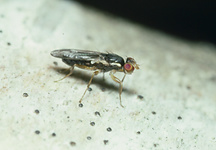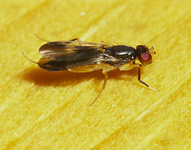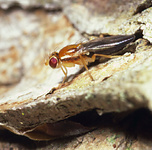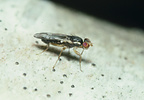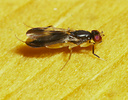Clusiodes
Owen Lonsdale and Steve MarshallIntroduction
Caloren & Marshall (1998) described the behaviour, biology and faunistics of the New World Clusiodes, and Roh?cek (1995) described that for species in the Czech and Slovak Republics.
European species of Clusiodes and Hendelia beckeri have been reared from puparia collected in numerous species of rotting deciduous tree trunks including aspen, ash, birch, poplar and alder (Caloren & Marshall 1998, Roh?cek 1995); several puparia and larvae of Clusiodes ruficollis have also been collected from under the bark of felled hornbeam in Britain (Withers 1985). North American Clusiodes have been reared from dead tulip trees (Liriodendron tulipifera L.) and likely develop in elm and maple (Caloren & Marshall 1998). Clusiodes species overwinter as puparia or late-instar larvae in the larval habitat (Caloren & Marshall 1998).
Adults of both genera are found predominantly on hardwood, but several Clusiodes species have been collected off of softwood trees such as pine, hemlock and fir (Caloren & Marshall 1998, Roh?cek 1995, Withers 1985). North American Clusiodes have also been found in association with rotting fungus (Caloren & Marshall 1998). We have also found small dung baits, particularly those placed on fallen wood that is bare and exposed, to attract adults of Clusiodes and Hendelia in the New World. Sasakawa (1998) notes that Clusiodes and Sobarocephala have been collected with Malaise traps or fruit fly traps baited with putrid pork.
Fallen trunks are usually the most reliable microhabitat at which to collect adult Hendelia and Clusiodes, since they are often used as lekking sites. Roh?cek (1995) noted that pale, conspicuous trunks (generally fallen trunks without bark) were selected by males of several Clusiodes species to attract females. Roh?cek (1995) also observed numerous teneral specimens of C. ruficollis emerging from a moist, rotten beech trunk; these newly emerged adults were seen to search for new logs to use them as mating places; males patrolled these logs defending territory, but females visited the mating sites only briefly to copulate, then searched for similar, but more rotten logs to oviposit in. North American Clusiodes have been noted to prefer treefalls (both new and old) in sunspots, where males perform wing-flicking displays (alone or with conspecifics) and 'ambush-style attacks', in addition to the territorial patrolling and head-to-head confrontations previously noted in European species (Caloren & Marshall 1998).
References
Caloren, D.C. & S.A. Marshall. 1998. A revision of the New World species of Clusiodes Coquillett (Diptera: Clusiidae). Studia Dipterologica 5:261-321.
Rohacek, J. 1999. Clusiidae. Folia Fac. Sci. Nat. Univ. Masaryk. Brun., Biol. 100: 291-293.
Withers, P. 1985. Notes on some British Clusiidae and reduction of Clusiodes facialis (Coll.) to synonymy. Proceedings of the Transactions of the British Entomological Natural History Society 18: 63-64.
Sasakawa, M. 1998. Family Clusiidae. In. Contributions to a Manual of Palaearctic Diptera; Volume 3: Higher Brachycera. L. Papp & B. Darvas (eds.), pp. 219-225. Science Herald, Budapest.
Title Illustrations
| Scientific Name | Clusiodes ater Melander & Argo |
|---|---|
| Specimen Condition | Live Specimen |
| Life Cycle Stage | Adult |
| Copyright | © Steve Marshall |
| Scientific Name | Clusiodes apiculatus Malloch |
|---|---|
| Specimen Condition | Live Specimen |
| Sex | Female |
| Life Cycle Stage | Adult |
| Copyright | © Steve Marshall |
| Scientific Name | Clusiodes melanostomus complex |
|---|---|
| Specimen Condition | Live Specimen |
| Life Cycle Stage | Adult |
| Copyright | © Steve Marshall |
About This Page
Owen Lonsdale
Insect Systematics Lab
Department of Environmental Biology
University of Guelph
Guelph, ON
N1G 2W1
Canada
Steve Marshall
Insect Systematics Lab
Department of Environmental Biology
University of Guelph
Guelph, ON
N1G 2W1
Canada
Correspondence regarding this page should be directed to Owen Lonsdale at and Steve Marshall at
Page copyright © 2005 Owen Lonsdale and Steve Marshall
- First online 25 August 2005
Citing this page:
Lonsdale, Owen and Marshall, Steve. 2005. Clusiodes. Version 25 August 2005 (under construction). http://tolweb.org/Clusiodes/27684/2005.08.25 in The Tree of Life Web Project, http://tolweb.org/





